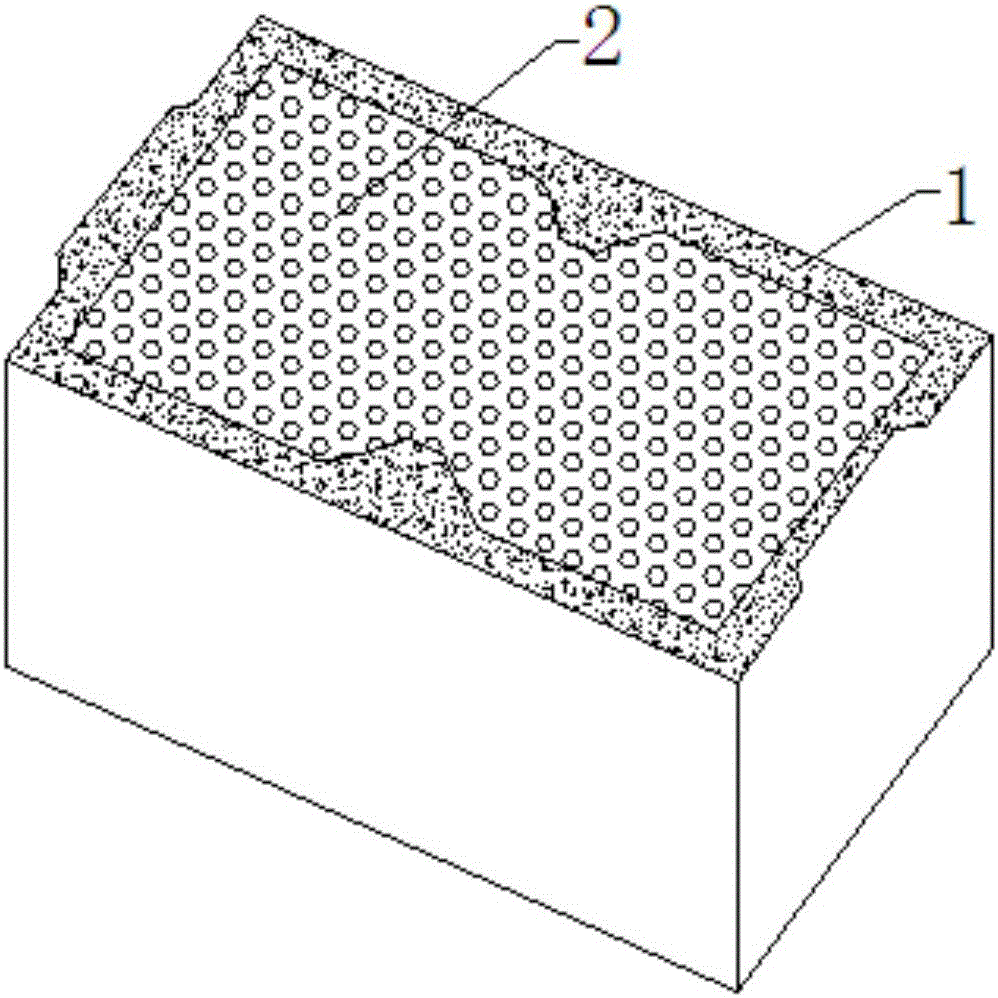Preparation method of lightweight self-thermal insulation building block containing abandoned brick particles and abandoned foams
A technology of self-insulating blocks and waste bricks, which is applied in the fields of ceramic products, solid waste management, sustainable waste treatment, etc., can solve the problems that the waste insulation boards of external walls cannot be processed, light aggregates cannot be used, etc., and achieve low prices , low equipment requirements and low production costs
- Summary
- Abstract
- Description
- Claims
- Application Information
AI Technical Summary
Problems solved by technology
Method used
Image
Examples
Embodiment 1
[0020] A method for preparing a lightweight self-insulating block containing waste brick particles and waste foam. The self-insulating block includes: a cavity module 1 and an insulating block 2 arranged in the cavity module 1. The preparation method includes the following steps :
[0021] (1) Break waste bricks into granular regenerated coarse aggregates below 10mm, break waste concrete blocks into recycled fine aggregates below 5mm, and break waste foam into foam particles below 10mm; Abandoned building bricks other than made bricks, waste foam is polystyrene material or extruded foam material;
[0022] (2) Mix recycled coarse aggregate, recycled fine aggregate, ordinary Portland cement and water at a mass ratio of 1:1:0.35:0.3 to obtain a four-mixture, and mold the above-mentioned four-mixture under a molding pressure of 100T Intermediate pressing 5S, demoulding to form cavity module 1;
[0023] (3) Mix 42.5 ordinary Portland cement, Class II fly ash, foam particles, liqu...
Embodiment 2
[0026] A method for preparing a lightweight self-insulating block containing waste brick particles and waste foam. The self-insulating block includes: a cavity module and an insulating block arranged in the cavity module. The preparation method includes the following steps:
[0027] (1) Break waste bricks into granular regenerated coarse aggregates below 10mm, break waste concrete blocks into recycled fine aggregates below 5mm, and break waste foam into foam particles below 10mm; Abandoned building bricks other than made bricks, waste foam is polystyrene material or extruded foam material;
[0028] (2) Mix recycled coarse aggregate, recycled fine aggregate, 42.5 ordinary Portland cement and water at a mass ratio of 1:0.5:0.15:0.15 (3min) to obtain four mixtures, and mold the above four mixtures at 100T Pressing 5S in the mold under pressure, demoulding to form a cavity module;
[0029](3) Mix 42.5 ordinary Portland cement, Class II fly ash, foam particles, liquid quick-settin...
Embodiment 3
[0032] A method for preparing a lightweight self-insulating block containing waste brick particles and waste foam. The self-insulating block includes: a cavity module and an insulating block arranged in the cavity module. The preparation method includes the following steps:
[0033] (1) Break waste bricks into granular regenerated coarse aggregates below 10mm, break waste concrete blocks into recycled fine aggregates below 5mm, and break waste foam into foam particles below 10mm; Abandoned building bricks other than made bricks, waste foam is polystyrene material or extruded foam material;
[0034] (2) Mix the recycled coarse aggregate, recycled fine aggregate, 42.5 ordinary Portland cement and water at a mass ratio of 1:0.5:0.35:0.20 (3min) to obtain a four-mixture, and mold the above-mentioned four-mixture at 80T Pressing 5S in the mold under pressure, demoulding to form a cavity module;
[0035] (3) Mix 42.5 ordinary Portland cement, Class II fly ash, foam particles, liqui...
PUM
| Property | Measurement | Unit |
|---|---|---|
| density | aaaaa | aaaaa |
| density | aaaaa | aaaaa |
| density | aaaaa | aaaaa |
Abstract
Description
Claims
Application Information
 Login to View More
Login to View More - R&D
- Intellectual Property
- Life Sciences
- Materials
- Tech Scout
- Unparalleled Data Quality
- Higher Quality Content
- 60% Fewer Hallucinations
Browse by: Latest US Patents, China's latest patents, Technical Efficacy Thesaurus, Application Domain, Technology Topic, Popular Technical Reports.
© 2025 PatSnap. All rights reserved.Legal|Privacy policy|Modern Slavery Act Transparency Statement|Sitemap|About US| Contact US: help@patsnap.com

